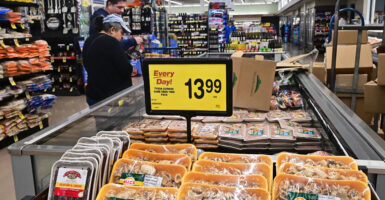If you’re having trouble affording groceries, don’t expect sympathy from the White House.
In a recent interview, President Joe Biden was told that food prices are up more than 30% on his watch. But he casually dismissed this fact, claiming people have money to pay those elevated prices.
This doesn’t just demonstrate Biden’s tone-deafness to the plight of Americans who struggle to afford necessities like groceries; it shows his ignorance of his own administration’s data.
According to the Bureau of Labor Statistics, average weekly paychecks have increased about $150 under Biden, or 14.1% in roughly three years. Normally, that would be cause for celebration, but not in the inflationary environment of “Bidenomics.”
Because prices have risen an average of 19.3% during Biden’s tenure, the average real, or inflation-adjusted, weekly paycheck has shrunk by about $50, or 4.4%. Today’s larger paychecks buy less, and consumers are being squeezed by higher prices everywhere.
This drop in purchasing power has many families relying on credit cards to make ends meet, pushing outstanding balances up to $1.1 trillion, even while the interest rate on that debt is at a record high.
Contrary to the president’s claim, it doesn’t sound like Americans have the money to pay 30% more for food.
As Americans put more necessities on their credit cards, finance charges alone have exploded to more than $200 billion per year. If people can’t afford rent and food, they certainly can’t afford mounting interest costs.
Those higher interest costs can also be seen on mortgages, student loans, and car loans. Between those higher finance charges and the lost buying power from declining real earnings, a typical American family lost $8,100 of their annual income compared with when Biden took office.
It’s no wonder people struggle to get by amid this cost-of-living crisis. Some major expenses, like a home renovation, can be put off in hard times. But food is a necessity, and there’s no avoiding these higher prices.
This hits lower-income families particularly hard, because consumers shift their buying habits when inflation is high to save money. As middle- and even upper-income shoppers buy lower-priced items from their grocer to save money, there is a surge in demand for foodstuffs that were disproportionately bought by lower-income households.
Eggs are just one example of this phenomenon. They have historically been a relatively inexpensive source of protein, vitamin D, and other nutrients. As more Americans swap purchases of things like beef with eggs to save money, the higher demand for eggs has pushed prices up much faster than the average inflation rate for food.
That’s a key reason why egg prices are up 40.9% under Bidenomics.
And eggs aren’t the only things at the grocery store that will induce sticker shock. Prices of other consumer staples such as flour, sugar, and butter have skyrocketed in price under Biden’s tenure, increasing 38.3%, 30.7%, and 35.9%, respectively.
Americans’ incomes haven’t risen nearly as quickly as food prices have during the Biden administration, resulting from failed public policy. Spending and borrowing trillions of dollars we didn’t have, manipulating interest rates, and printing money to try to pay it all has crushed American consumers under an elephantine cost of living and burgeoning debt.
Sadly, Biden seems blissfully unaware not only of the extent of this problem, but also of his role in taking food out of the mouths of Americans.
Originally published at WashingtonTimes.com

























